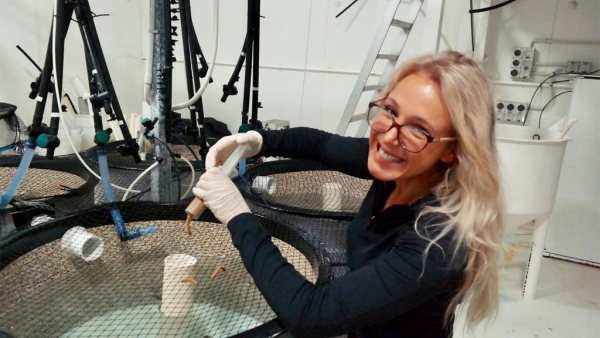Some of the first research into how microplastics are affecting New Zealand fish species has revealed that microplastic fragments can find their way through the gut lining and into muscle tissue.
Experiments carried out by two masters students from the NIWA and University of Auckland Joint Graduate School of Coastal and Marine Science have shown that some fish species ingest more microplastics than others in the Hauraki Gulf, but that almost 25% of all fish sampled had microplastics in their guts.
Microplastics are defined as pieces of plastic less than 5mm long and are either manufactured to be small or derived from larger plastics that have broken down into smaller pieces. Identifying them in fish gut samples requires specialised laboratory equipment and protocols to ensure all potential sources of contamination are eliminated.
Devina Shetty focused on six fish species commonly found within the Gulf: snapper, yellowbelly flounder, gurnard, jack mackerel, kahawai and pilchard. Microplastics were found in 70 of 305 fish specimens, which included more than half of the yellowbelly flounder sampled.
“This higher ingestion rate for flounder could be due to microplastics accumulating in marine sediments which makes up more of their diet compared to other species, or it could be because the flounder samples were all obtained from the Waitemata Harbour, which is closer to Auckland as a potential microplastic source,” she said.
Ms Shetty said she was surprised by the results.
“As an island nation in the South Pacific with relatively low population numbers you would expect to see lower ingestion rates so I was a bit surprised when half of the flounder species had ingested mostly microfibers. However, given that they were caught near Waitemata Harbour, which is closer to Auckland as a potential microplastic source and are a benthic species (70% of plastics sink to the bottom of the seafloor) it makes sense.”
Veronica Rotman focused on hoki from the West Coast of the South Island, Cook Strait and the Chatham Rise. One or more microplastics were found in the stomachs of 95% of the 60 fish examined, with 90% of the particles identified as fibres.
Ms Rotman also completed a 10-week tank experiment at NIWA’s Northland Marine Research Centre in which snapper were fed a diet containing polystyrene microplastic feed at different concentrations. She found that those fed a higher concentration were more likely to have microplastic in their white muscle tissue.
“This suggests that ingested microplastics can translocate from the gut and into the muscular tissue in small numbers (1-2 per fish) at tiny sizes, potentially making that plastic available to anything that eats that muscle tissue, whether it be larger fish or potentially humans.”
Ms Rotman also observed significant inflammatory, vascular and structural changes to the intestine with only a low ‘environmentally relevant’ microplastic treatment, suggesting that similar damage is occurring in the wild. The damage to the intestine increased with microplastic concentration, with 60% of high treatment fish displaying severe alterations.
While this gut damage didn’t lead to any significant effects on growth or mortality in the 10 week experiment conducted, it demonstrates that microplastic has significant negative effects on the fish that eat it.
“The intestine is fundamental for the absorption of nutrients and changes to the structure found in this experiment would ultimately impair nutrient absorption and growth in the long term. Further ingestion of microplastics may compromise the permeability, efficiency and immunological response of the digestive tract affecting organ function, reproductive success, growth and ultimately, survival”.
NIWA fisheries scientist and University of Auckland‘s Dr Darren Parsons, who oversaw the projects, said there had only been one previous study looking at the effects of microplastics on New Zealand fish species and these studies provided some valuable insight into what has become an issue of huge concern.
“Microplastics are found throughout the world’s oceans, even in Antarctica. They pose a unique threat to marine life.”
The next steps in this research would be to focus on the microfibres that are the most common type of microplastic found in the ocean, and to conduct more comprehensive experiments to establish the long-term effects of microfibres on fish.


